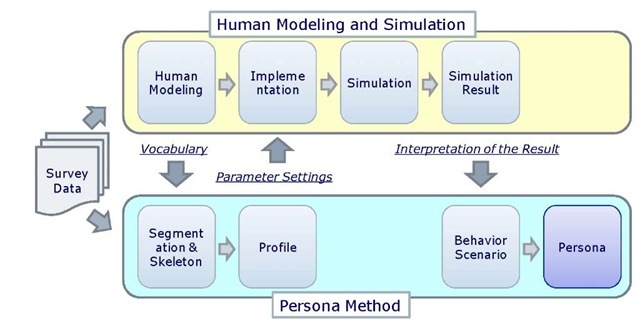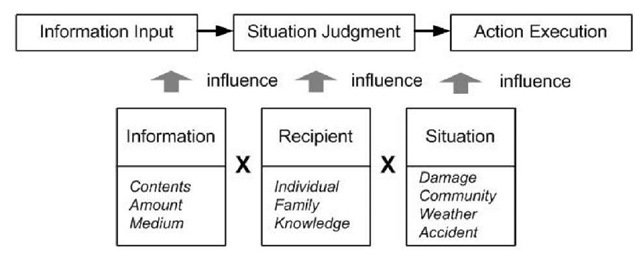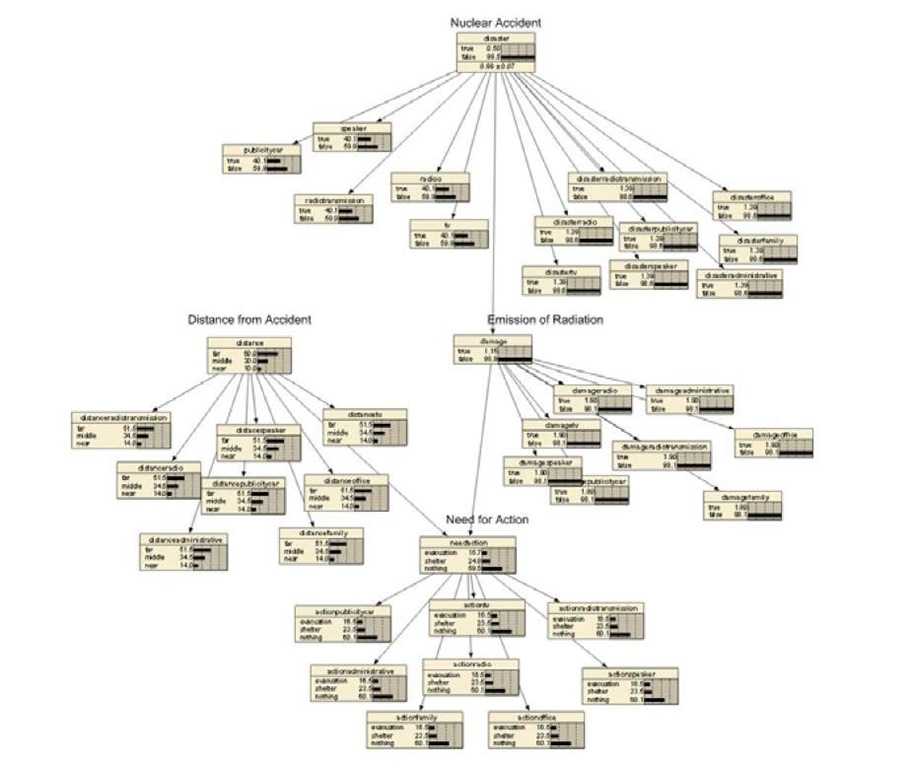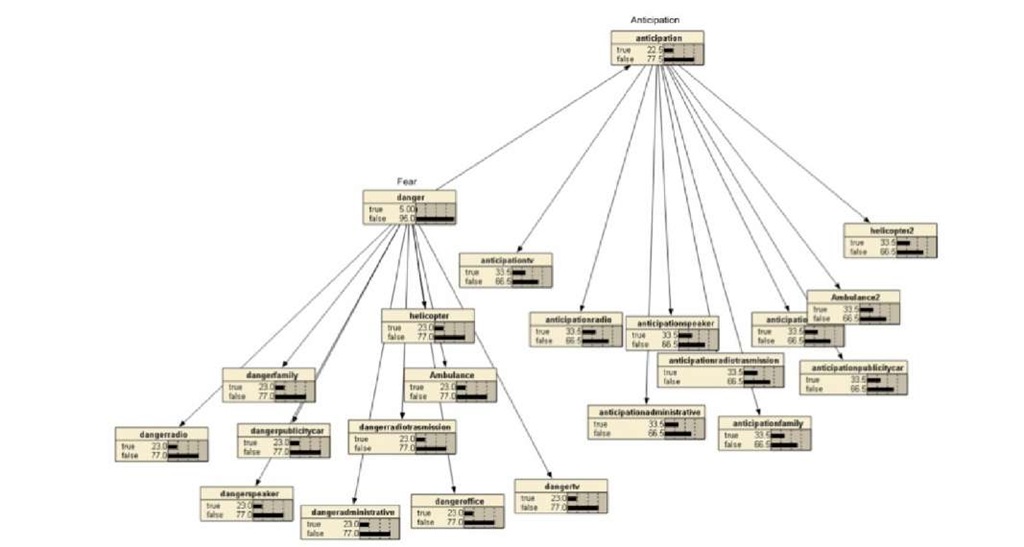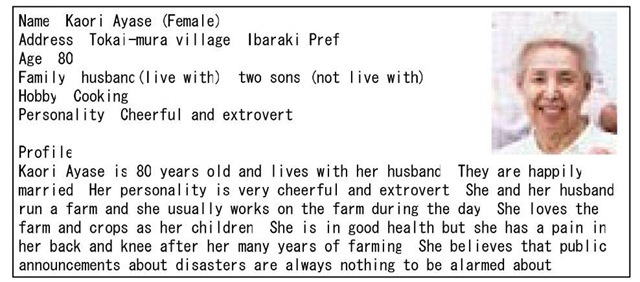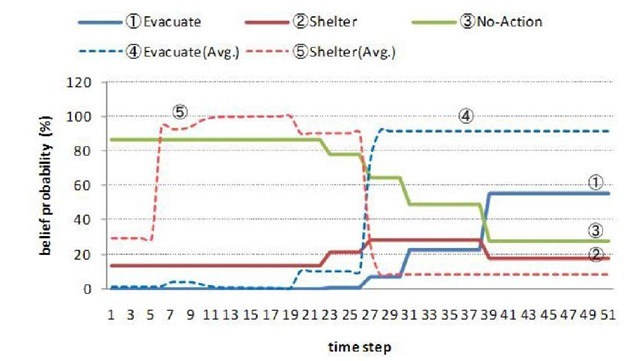Abstract
This paper proposes a method to integrate human modeling and simulation with the persona method to efficiently predict human behavior with different personalities in a variety of situations. We have applied the method to predict residents’ behavior in an emergency situation to design emergency announcement strategies and have confirmed that this method can semi-automatically construct several different personas and their behavior scenarios successfully. The method provides a systematic procedure for creating personas and is expected to reduce time and cost in the design process.
Keywords: Human modeling and simulation, persona method, user scenario, emergency announcement.
Introduction
Human modeling and simulation is an effective method for predicting human behavior under various parameter settings and for finding potential problems from the results without costly and time-consuming user tests and experiments. To date, in HCI studies there are many good examples of simulation studies based on a human model, such as the estimation of users’ reaction times through simulation with Card’s information processing model (Cards 1983), prediction of users’ reactions as well as human errors by ACT-R based simulations (Anderson 1998). One of the limitations of this approach, however, is that it is difficult to validate the results, owing to the difficulty of obtaining sufficient corresponding actual data for comparison. Another limitation is that parameter tuning to represent personal differences or personalities is relatively arbitrary. It is therefore, not reliable to use human modeling and simulation to predict human behavior in contexts where these limitations are critical and not insubstantial. Another approach to predicting human behavior for HCI design or product design is the persona method. Personas are fictional characters created to represent the different user types within the targeted user groups.Personas help design team members share a particular image of the target users and promote simulation of user behaviors and their needs. Many man-hours, however, are required to create a persona, particularly to produce a user scenario that gives a typical but virtual context for estimating user behavior. In this paper, we propose a method that combines the above two methods to compensate for the limitations of each. We have applied the method to the creation of personas to predict residents’ behavior in an emergency situation to design emergency announcement strategies.
In the next section, we explain how these two approaches are integrated, while in Section 3, we present the details of the human model used in the case study. In Section 4, we introduce an example of applying the method to the design of an emergency announcement strategy. A discussion and our conclusions are presented in Section 5.
The Proposed Method
An overview of the proposed method is illustrated in Fig. 1. The upper process corresponds to human modeling and simulation, while the lower one corresponds to the persona method. The intermediate outputs from each process are used to integrate these two processes. The proposed method follows the steps given below.
1. Define target user groups based on the survey data and create skeletons and detailed user profiles. This is the initial step in the persona method. In this step, the human model can be used to describe the skeletons, i.e., the model provides the vocabulary for this process.
2. Develop a human model to describe and explain target human behaviors, which is a typical human modeling process.
3. Set model parameters based on the user profiles. In most human models, the parameter set is arbitrary; any combination of parameters can be tested, but there are no good guidelines for setting appropriate parameters to represent specific user characteristics. The target groups with demographic details help determine these parameters.
4. Run the simulation with the parameter sets and obtain time-series behaviors of the output parameters. In most simulation studies, we usually analyze and discuss this result to predict human behavior. However, as mentioned in the previous section, in some cases it is difficult to validate the simulation result, and thus, the reliability of such predictions may be lowered.
Fig. 1. Overview of the proposed method
5. Interpret the result and give a narrative explanation of the simulation result considering both the time-series behavior of the result and the environmental assumptions of the simulation. In the persona method, we need to create a user scenario that describes typical behavior patterns, goals, skills, attitudes, and the environment to make the persona a more realistic character. This requires many man-hours and skills. The interpretations are semi-automatically generated according to a guideline, which becomes a user scenario.
6. Complete a persona. Because human modeling and simulation are only used to generate user scenarios to stimulate the imagination, and not to make critical decisions, we can use the method even if it is not totally reliable.
Model of Residents’ Behavior in a Disaster
In this study, we applied the proposed method to the design of an emergency announcement system that considers a variety of residents’ characteristics. In our previous study, we developed a model for the residents’ decision making process in the event of a nuclear accident and confirmed that the model and simulation could clearly explain the residents’ responses in an actual disaster (Kanno, Shimizu and Furuta 2006). We used an extended version of this resident model for the case study. This section explains the details of this model.
The Qualitative Model
Fig. 2 shows an overview of the model. This model consists of the process of establishing residents’ behaviors, together with the influencing factors and their effects on the process extracted from the case analyses.
We modeled the process on a conventional stimulus-organism-response (S-O-R) model for human information processing (Woodworth 1958). The first step ("S") includes the process of obtaining relevant information from the environment, media, and other sources. Comprehending the information and judging its trustworthiness is also carried out in this step. Then, based on the information obtained, recognition of the current situation, particularly the recognition of danger, the need for action, or fear, occurs in the "O" step. Based on the results of the previous two steps, decisions as to whether or not one should take some concrete action are made in this step ("R"). Various influencing factors on these steps such as the attributes of the information, characteristics of residents, and environmental conditions have also been reported.
Implementation with Bayesian Belief Network
An extended version of the previous simulation model is used in this study. The main part of the previous model was implemented with a Bayesian belief network (BBN) shown in Fig. 3. This BBN corresponds to the information input and situation judgment process and outputs the probabilities of the nodes. The probabilities of the symptom nodes in this BBN represent the status of "with" or "without" information about the content provided by the various information media. In our design the evidence value is gradually increased with the times of acquisition to represent the qualitative influence of the amount of information. The previous model introduced an attention and an action barrier to represent, respectively, the difficulties in information acquisition and hesitations in action. Both work as the thresholds for information acquisition and action execution.
Fig. 2. Qualitative model for resident response
Fig. 3. Bayesian network for situation assessment
Fig. 4. Bayesian network for fear and anticipation
Based on the previous model, in this study we also considered the effects of fear and anticipation in an emergency. The causal network underlying such mental status triggered by the information obtained from the environment, mass media, and other sources, was implemented with a separate BBN as shown in Fig. 4. The probabilities of the symptom nodes in this network also represent the status of "with" or "without" information about the content provided by various information media. The belief probabilities of these symptom nodes are propagated and the network outputs the belief probability of the node for "Fear" and "Anticipation". This value affects the sensitivity to new information in the first BBN. That is, if the probability increases/decreases, then a resident is becoming more/less sensitive to new information from the environment, mass-media, or other sources. This value also affects the value of "Need for Action" as shown in Table 2. Whether a resident will take an action is determined by the corrected value (P’) of the node "Need for Action". The coefficients used in this study are given in Table 2. P’ is calculated by multiplying these coefficients and then normalizing for comparison with the threshold (the action barrier) for each action to determine whether he/she carries out the action.
Case Study
We applied the proposed method to the design of an emergency announcement system that considers various residents’ characteristics in the event of a nuclear accident. First, by reviewing the reports and journal papers about the residents’ behavior in the JCO criticality accident in 1999 in Japan (Furuta et al., 2000; Umemoto et al., 2000), we selected several important characteristics of residents and their behavior. Then, we set the target group as those who did not adopt a quick and appropriate response in the accident, and developed further categories for these residents as shown in Table 1.
Table 1. Key characteristics of the target groups
|
Characteristics |
Explanation |
|
Older people |
• They often have trouble in hearing public announcements. • They have some physical problems. |
|
Male/Female |
• Males in general are relatively insensitive. |
|
Possessing fixed assets |
• They are often reluctant to evacuate because of their assets. |
|
Adverse effect of disaster experience |
• Cry-wolf syndrome. |
Resident Profile and Parameter Settings
We created five skeletons and their detailed profiles based on a combination of the above five characteristics. Fig. 5 presents an example of a resident profile with all five characteristics; this persona is that of an old female who owns fixed assets (a farm and crops). From past experience, she distrusts public emergency announcements. Based on this detailed profile and the parameters shown in Table 2, the BBN resident model of this persona is constructed.
Fig. 5. Profile of a persona
Simulation Results and a Scenario Guideline
We used the same input messages (announcements) as in the previous study (Kanno, Shimizu and Furuta, 2006), which were made based on the actual announcements broadcast by governmental agencies or the mass media during the JCO accident. Each announcement is written in XML format and contains information about the content, medium used, and the time when it is announced. Resident agents receive the announcement if they are paying sufficient attention as well as satisfying physical and spatial conditions. After receiving the announcement, the resident agents update the probabilities of the BBN and proceed to situation judgment and action execution if necessary. In this simulation, the set of announcements during an emergency is the input, and the time-series behavior of the values of each agent’s BBN is the output.
Table 2. Coefficients of Actions
|
category |
evacuate |
shelter |
nothing |
|
With Assets |
0.7 |
0.9 |
1.3 |
|
Without Assets |
1 |
1 |
1 |
|
Age over 80 |
0.6 |
1.2 |
1.4 |
|
Age under 80 |
1 |
1 |
1 |
|
Male |
0.8 |
0.9 |
1.2 |
|
Female |
1 |
1 |
1 |
|
Anticipation (p) |
if p > 0.65 then |
if p > 0.65 then |
if p > 0.65 then |
|
2 |
2 |
2 |
|
|
else 0.05 |
else 0.05 |
else 0.05 |
Fig. 6. Simulation Results
Fig. 6 shows transitions in belief of "Need for Action" nodes. The dashed lines represent the action of a normal persona who decides to evacuate after the announcement around the 25th step, while the solid line represents that of the target persona. As shown in Fig. 6, the persona developed a competing but lower value for the belief probability between ”Shelter” and ”Evacuate” after the announcements and consequently did not take either action. The result contains rich data not only about situations and events happening in the simulation, but also about a persona’s cognitive status such as attention, information acquisition, situation assessment, and action execution, and thus the analysis of these results can create a detailed story about Kaori Ayase during the accident.
Table 3. Example of the Scenario Guide
|
Observed Event |
Reason |
Interpretation |
|
could not obtain information |
lack of attention |
• did not hear an announcement because he/she was at home • not paying much attention to it |
|
did not watch/listen |
• because he/she did not watch tv or listen to the radio |
|
|
weak hearing |
• because he/she has weak hearing |
|
|
working |
• not aware of the information because he/she was working hard |
|
|
did not evacuate |
a farmer |
• because he/she was worried about his/her farm and crops |
|
a fisherman |
• because he/she was worried about his/her fishing boat |
|
|
adverse effect of disaster experience |
• because he/she distrusts public announcements • because he/she remembers a similar situation that turned out to be a false announcement |
|
|
male |
• because he is somewhat obtuse |
To interpret the simulation results easily and create a resident scenario, we developed a list, as shown in Table 3, of partial narrative scenarios that explain excerpts of a simulation result in terms of the model and parameters. The leftmost column represents possible events we can find in a simulation result while the center column represents influencing factors on those events. Narrative scenarios for an observed event considering the influencing factor are listed in the rightmost column. By analyzing the result and consulting this list, resident scenarios can be semi-automatically created.
Results
Fig. 7 gives the resident scenario for Kaori Ayase created by the proposed method. The parts underlined with a dashed line correspond to the descriptions based on the profile. Those with a solid single underline correspond to the interpretations of the simulation result concerning situations and events, and those with a solid double underline correspond to the interpretation of the cognitive aspects of the results. For example, the first sentence comes from her profile, while the second describes the announcement in the simulation configured in the input data. The third sentence describes the behavior of the value of a symptom node after the announcement.
Discussion and Conclusions
We proposed a method to integrate human modeling and simulation with the persona method for efficient prediction of human behavior with different personalities in various circumstances. Through the case study, we confirmed that the resident scenarios are not inconsistent with the survey data and the insight obtained from empirical knowledge and thus the proposed method is applicable for creating personas for the design of an emergency announcement system. Moreover, creating a resident scenario from the simulations results was relatively easier and required fewer man-hours than the standard process based on the creator’s imagination.
One of the disadvantages of such human modeling and simulation as used in this study is that it is virtually impossible to validate the results, owing to the lack of actual data for comparison purposes. It is, therefore, difficult to apply this method directly to predict human behavior in serious issues, such as those presented in the case study that require critical decision making. However, since the proposed method uses the simulation as a means to create a resident scenario for a persona, the disadvantage becomes less critical. In other words, because a persona aims to stimulate the designer’s imagination to predict human behavior and to find potential problems, a resident scenario is not required to be highly reliable. In this sense, the proposed method is an example of using less reliable human modeling and simulation for a real-life practical problem.
